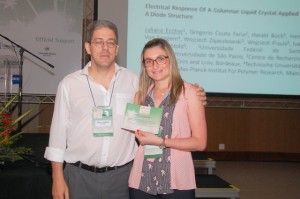
Awarded work: Electrical response of a columnar liquid crystal applied in a diode structure. Juliana Eccher1, Gregorio Couto Faria2, Harald Bock3, Heinz Von Seggern4, Wojciech Zajaczkowski5, Wojciech Pisula5, Ivan H. Bechtold1; 1Universidade Federal de Santa Catarina, 2Universidade de São Paulo, 3Centre de Recherche Paul Pascal, Cnrs and Univ.Bordeaux, 4Technische Universität Darmstadt, 5Max-Planck-Institut For Polymer Research, Mainz.
The Bernhard Gross Award for the best oral presentation of the XIII SBPMat Meeting was given to a pioneer research in Brazil in its theme. “In my opinion, the main significance of awarding this work regards the dissemination of the research involving liquid crystals as organic semiconductors for applications in the field of organic electronics, especially concerning Brazil, since there are only a few groups working towards this research line in the country”, said the newly Ph.D. graduate Juliana Eccher, who presented her paper at the symposium D on materials and organic electronic devices.
Graduated in physics from the Federal University of Santa Catarina (UFSC), Juliana decided to pursue an academic career in the field of experimental physics and chose to obtain her Masters and Ph.D. degrees at UFSC, both in the field of materials, more precisely in the study of liquid crystals . “Research in materials is fascinating because it offers a broad range of study in various fields of knowledge,” said Juliana, who attended the meeting of SBPMat on three occasions. “What attracts me the most is the possibility of new discoveries and the diversity of applications,” she added.
Liquid crystals, materials used in widely marketed LCD screens, have recently been recognized as a promising class of self-organized organic semiconductors with a high electrical mobility. Some of them are called columnar because their molecules, shaped like discs, are piled on top of each other forming stable columns. When the columns are aligned perpendicularly to the substrate, there is homeotropic alignment – an ideal configuration for the application in OLEDs (organic light emitting diodes) and OPVs (organic photovoltaic devices).
Juliana Eccher´s winning work, developed during her Ph.D. in Physics, with the supervision of Professor Ivan Bechtold, studied a thin film of liquid crystal based on perylene-diimide aromatic center and proposed a relation between its electrical properties and its molecular organization. The liquid crystal was investigated within a diode structure. The work was supported by the Brazilian Federal Council for Scientific and Technological Development (CNPq), in particular through INCT/INEO , and by the Brazilian Federal Agency for the Support and Evaluation of Graduate Education (CAPES).
Juliana and the other members of the team could obtain homeotropic alignment in films deposited by spin-coating technique by subjecting them to annealing, resulting in an increase of five orders of magnitude in the electrical mobility and also a significant increase in the electroluminescence intensity of the device.
A Ph.D. research with international collaborations
The work was made possible thanks to several international collaborations. The synthesis of the organic compound was carried out by Dr. Harald Bock of the Centre de Recherche Paul-Pascal, CNRS, in France, collaborator since 2010 of the Laboratory of Organic Optoelectronics and Anisotropic Systems at the Department of Physics, UFSC, which is coordinated by Professor Bechtold. Initially in Brazil, by means of a collaboration with Professor Gregório Faria of the São Carlos Institute of Physics at USP, the team began to investigate the potential of organic material as emitting layer in a diode structure. Furthermore, in 2013, Juliana underwent a research internship in Professor Heinz von Seggern´s group at the Technische Universität Darmstadt, in Germany, where she managed to manufacture the devices and make their electrical characterization. While beeing in Germany, Juliana established a collaboration with Dr. Wojciech Pisula, of the Max-Planck-Institut for Polymer Research, which group conducted analyses by grazing incidence wide angle x-ray scattering (GIWAXS), which were fundamental to investigate the orientation of the columns with respect to the surface. Finally, with the collaboration of Professor Gregório, a theoretical model was developed for the analysis of electrical measurements of current density as a function of the applied voltage.
“The major achievement in my Ph.D. thesis was to show that, depending on the desired application, it is possible to modify and control the orientation of liquid-crystalline domains with respect to the electrodes, which significantly improved the electrical properties of the devices,” said Juliana.
To learn more about this work
– Scientific article published: J. Eccher, G. C. Faria, H. Bock, H. von Seggern, I. H. Bechtold. ACS Appl. Mater. Interfaces 5, 11935-11943 (2013).
– Juliana Eccher´s presentation at Symposium D of the XIII SBPMat Meeting:
